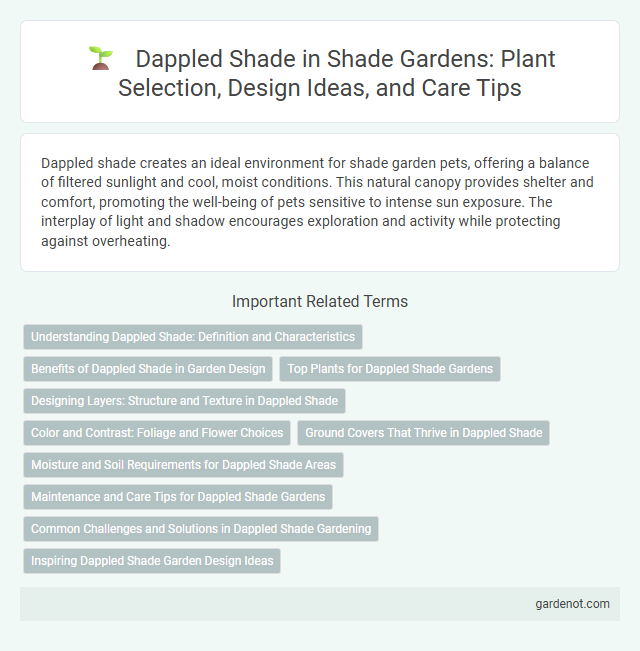Dappled shade creates an ideal environment for shade garden pets, offering a balance of filtered sunlight and cool, moist conditions. This natural canopy provides shelter and comfort, promoting the well-being of pets sensitive to intense sun exposure. The interplay of light and shadow encourages exploration and activity while protecting against overheating.
Understanding Dappled Shade: Definition and Characteristics
Dappled shade occurs when sunlight filters through the leaves of trees, creating a mix of light and shadow that changes throughout the day. This type of shade is characterized by intermittent sunlight patches that provide plants with moderate light exposure, ideal for shade-tolerant species like hostas and ferns. Understanding dappled shade is essential for designing gardens with plants that require partial sunlight and thrive in fluctuating light conditions.
Benefits of Dappled Shade in Garden Design
Dappled shade provides an ideal microclimate in garden design by filtering sunlight through tree canopies, reducing heat stress on plants and conserving soil moisture. This partial light environment promotes the growth of diverse shade-tolerant species, enhancing biodiversity and visual texture. Gardeners benefit from lower water requirements and extended plant health, making dappled shade a sustainable choice for vibrant, resilient landscapes.
Top Plants for Dappled Shade Gardens
Top plants for dappled shade gardens include hostas, ferns, astilbes, and heucheras, known for their adaptability to low light and moisture conditions. Japanese forest grass (Hakonechloa) and bleeding heart (Dicentra) add texture and vibrant color under filtered sunlight. These plants thrive in shaded gardens by enhancing biodiversity while requiring minimal maintenance.
Designing Layers: Structure and Texture in Dappled Shade
Dappled shade creates an ideal environment for layering diverse plants with varying textures, enhancing both depth and visual interest in shade gardens. Incorporate structural elements such as ferns, hostas, and astilbes to build contrast between broad, smooth leaves and delicate, feathery foliage. Combining these textural variations with dynamic height changes accentuates the natural light patterns/filtering typical in shaded areas, enriching garden design.
Color and Contrast: Foliage and Flower Choices
Dappled shade creates an ideal environment for vibrant foliage and flower combinations that enhance visual interest through varied textures and hues. Plants like hostas with their broad, variegated leaves contrast strikingly against the delicate blooms of astilbes or bleeding hearts, producing dynamic color interplay. Incorporating ferns or heucheras adds depth with rich greens and purples, elevating contrast and highlighting the natural soft light filtering through tree canopies.
Ground Covers That Thrive in Dappled Shade
Ground covers that thrive in dappled shade include Ajuga reptans, Pachysandra terminalis, and Lamium maculatum, which adapt well to filtered sunlight under trees. These plants improve soil retention and suppress weeds while offering vibrant foliage and flowers. Selecting shade-tolerant species like Epimedium and Vinca minor enhances the aesthetic appeal and biodiversity of shade gardens.
Moisture and Soil Requirements for Dappled Shade Areas
Dappled shade areas require soil that retains consistent moisture while also offering good drainage to prevent root rot. Rich, loamy soils with organic matter such as compost enhance water retention and nutrient availability for shade-tolerant plants. Regular mulching helps maintain soil moisture levels and supports healthy root development in dappled shade environments.
Maintenance and Care Tips for Dappled Shade Gardens
Dappled shade gardens require regular monitoring of soil moisture to prevent both dryness and waterlogging, ensuring plants thrive in filtered sunlight. Mulching with organic materials helps retain moisture and suppress weeds, reducing maintenance efforts. Pruning selectively maintains airflow and encourages healthy growth, preventing fungal diseases common in shaded environments.
Common Challenges and Solutions in Dappled Shade Gardening
Dappled shade gardens often face challenges such as uneven light distribution, which can lead to inconsistent plant growth and difficulty in selecting suitable species. To address these issues, choosing shade-tolerant plants like hostas, ferns, and astilbes ensures better adaptation to filtered sunlight conditions. Proper soil preparation and regular mulching improve moisture retention, mitigating stress on plants caused by fluctuating light and water availability.
Inspiring Dappled Shade Garden Design Ideas
Dappled shade creates a perfect balance of sunlight and shadow, ideal for cultivating a lush variety of shade-loving plants such as hostas, ferns, and astilbes. Incorporate layered planting with textured foliage and colorful blooms like rhododendrons and hellebores to enhance visual interest and depth. Utilizing natural elements like stone pathways and wooden benches can emphasize the tranquil, woodland atmosphere of a dappled shade garden.
Dappled shade Infographic

 gardenot.com
gardenot.com